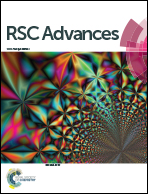Palladium-loaded magnetic core–shell porous carbon nanospheres derived from a metal–organic framework as a recyclable catalyst†
Abstract
Separation and recycling of noble metal nanocatalysts after catalytic reactions are significant challenges to reduce catalyst cost and avoid waste generation in industrial applications. In this study, Pd-loaded magnetic porous carbon nanospheres (Fe3O4@MC-Pd) were prepared by annealing Fe3O4@MIL-100/PdCl2, which was fabricated through a facile one-pot solvothermal method, at 450 °C in a nitrogen atmosphere. The novel Fe3O4@MC-Pd catalyst consists of a superparamagnetic Fe3O4 core and a chemically inert porous carbon layer, which can protect the Fe3O4 core from extreme external environments and prevent the loss of Pd NPs. The resultant composite material showed excellent catalytic performance in reducing methylene blue with sodium borohydride as a reducing agent and superparamagnetic behavior that enabled the magnetic separation and convenient recovery of the nanocatalysts from the reaction mixture. Moreover, the composite material also showed good thermal and acid stability, fast regeneration ability, and high cyclic stability (>10 cycles without loss of catalytic efficiency). The result shows the nanocatalysts could overcome the drawbacks of MOF catalysts (chemical unstability). This study indicated that the as-prepared Fe3O4@MC-Pd composite material shows great potential for using in a wide range of applications.


 Please wait while we load your content...
Please wait while we load your content...